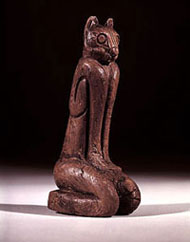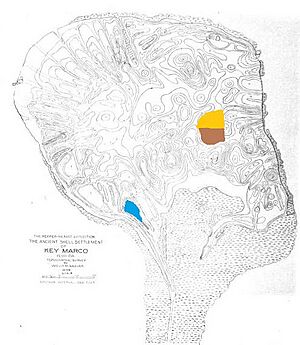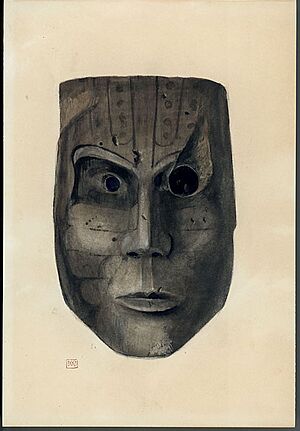Key Marco facts for kids

Key Marco was an amazing old place in Florida where people lived a long time ago. It was an island made of shell works, which are mounds and structures built from shells. This special island was right next to Marco Island.
A small pond on Key Marco, called the "Court of the Pile Dwellers," was dug up by scientists in 1896. A man named Frank Hamilton Cushing led this team from the Smithsonian Institution. They found over 1,000 wooden objects in the pond! This was the biggest collection of old wooden items ever found in the eastern United States.
These objects are considered some of the most beautiful ancient Native American art in North America. Today, you can see these amazing finds in museums like the University of Pennsylvania Museum of Archaeology and Anthropology, the National Museum of Natural History, and the Florida Museum of Natural History. The original pond was completely dug out and then filled in. Now, houses cover the area. Scientists also did smaller digs at Key Marco in 1965 and 1995.
What's in a Name?
In the late 1800s, Key Marco was a separate island made of shell mounds. A small town called Marco Village was built there. The Olde Marco Inn, a hotel, opened in 1887. Later, in 1927, the town's name changed to Collier City.
By the end of the 1900s, Key Marco was connected to Marco Island. All the shell mounds were flattened to build houses. This area is now known as Old Marco Village. Sometimes, people get confused because the name "Key Marco" was also used for all of Marco Island by one writer.
Another confusing thing is that in the 1980s, a company renamed Horr's Island as "Key Marco." Horr's Island is a very important archaeological site on its own. It has one of the oldest burial mounds in the eastern U.S., dating back to about 1450 BCE. It was also home to a large, permanent community during the Archaic period (8000 BCE - 1000 BCE).
The Pepper-Hearst Dig
The "Court of the Pile Dwellers" at Key Marco was a small, muddy pond. It was less than one acre in size. The muddy conditions in the pond were perfect for keeping wood and other objects from rotting. This is why so many things made of wood, bone, fiber, and animal skin were found there. Objects made of stone, shell, and pottery were also found.
Many different kinds of objects were discovered in the pond. These included bowls, tools for grinding food, spears, and atlatls (spear throwers). They also found cords, ropes, fishing nets, net floats, and fishhooks. There were carved clubs, wooden tablets, and plaques. Even wooden ear spools (jewelry for ears) were found.
Some of the most exciting finds were realistic carved animal heads and carved, painted masks. There was also a famous carved wooden figure that looks like a cat and a human, known as the "Key Marco cat." Many of the wooden objects, including the masks, had been painted with bright colors. These colors were still very clear when the objects were first taken out of the mud.
When the pond was dug up, scientists didn't have good ways to keep wood and other fragile materials from falling apart after they were removed from the wet mud. So, the colors on the painted objects quickly faded. Many objects also started to break down. Luckily, a photographer on the team took pictures of everything right after it was found. This helped save what they looked like. Also, watercolor paintings were made by Wells Moses Sawyer to show the original colors of the painted objects.
Dating the objects from the "Court of the Pile Dwellers" has been tricky. At the time of the dig, archaeologists didn't keep detailed records of which objects were found deeper in the ground. This means we can't easily tell which objects are older than others. There were no signs of European goods, so we know these objects are from before Europeans arrived.
The method called Radiocarbon dating didn't exist back then. Trying to radiocarbon date objects that have been handled and stored for a long time can also be unreliable. In the 1960s, one attempt to date some objects suggested they were from 1670 AD. A second try in 1975, using five different objects, gave dates ranging from 55 AD to 850 AD.
Later Discoveries
In 1965, scientists named Van Beck and Van Beck dug up part of a 4.5-meter (about 15-foot) tall mound. This mound was about 200 meters (about 650 feet) northeast of the "Court of the Pile Dwellers." They found many pieces of broken pottery in different layers of the mound. These pottery pieces belonged to the Glades culture, from periods II and III. The large number of pottery pieces suggests that many people lived at Key Marco during these times. This also hints that their society might have been quite organized.
In 1995, the Collier County Historical Society started another archaeological project. This was on an undeveloped part of Key Marco. Archaeologists Randolph J. Widmer and Rebecca Storey led this effort with volunteers. They hoped to learn more about the site Cushing had dug up. They found signs of three different stages of platform mounds. These mounds had large houses built on top of them using wooden posts. They found 55 distinct layers in the ground, showing changes in how shells and sand were mixed. They also found many postholes, which are holes where wooden posts once stood. These showed that large structures were built on stilts to raise them above the mound's surface. They found more evidence of the early Glades culture, mainly through pottery remains.
Who Lived There?
Marco Island was home to the Muspa people. In archaeology, this group is part of the Glades culture in the Ten Thousand Islands area. Around 1300 AD, the pottery and art styles in the Muspa area started to look very similar to those of the Calusa people to the north. This suggests that the Muspa became closely connected with or even joined the Calusa people.
Images for kids





